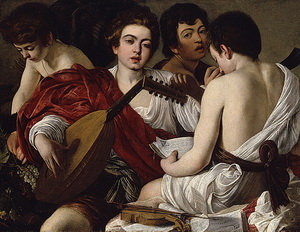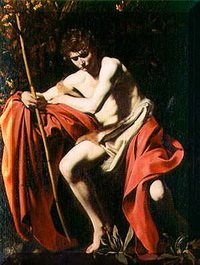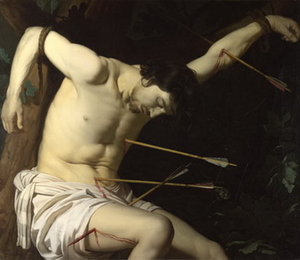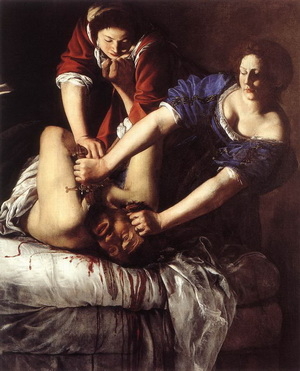The National Gallery in Ottawa has scored a coup with its blockbuster Caraviggo exhibition that runs until Sept. 11.
Caravaggio and His Followers in Rome features ten paintings never before seen in North America, two that have, and another 50 paintings by artists who were influenced by his work. In view of the fact that only 70 of the artists works known to exist, and many of them are altar pieces that cannot be moved, it’s an extraordinary collection.
 “Caravagio was a character out of the film “Fight Club.” Said the gallery director, Mark Mayer, “He was someone who was on the lam for the last 15 years of his life for all kinds of crimes and misdameanours.” Caravaggio’s painting are an expression of his own outlaw exuberance, fashioned from darkness and light. As Andrew Graham Dixon writes in his Caravagio biography, A Life Sacred and Profane, “His pictures represent spotlit moments of extreme and often agonized human experience. A man is decapitated in his bedchamber, blood spurting from a deep gash in his neck. A man is assassinated at the high altar of a church. A woman is shot in the stomach with a bow and arrow at point blank range. Caravagio’s images freeze in time, but also seem to hover on the brink of their own disappearance.”
“Caravagio was a character out of the film “Fight Club.” Said the gallery director, Mark Mayer, “He was someone who was on the lam for the last 15 years of his life for all kinds of crimes and misdameanours.” Caravaggio’s painting are an expression of his own outlaw exuberance, fashioned from darkness and light. As Andrew Graham Dixon writes in his Caravagio biography, A Life Sacred and Profane, “His pictures represent spotlit moments of extreme and often agonized human experience. A man is decapitated in his bedchamber, blood spurting from a deep gash in his neck. A man is assassinated at the high altar of a church. A woman is shot in the stomach with a bow and arrow at point blank range. Caravagio’s images freeze in time, but also seem to hover on the brink of their own disappearance.”
 The show offers an opportunity to come face to face with his masterpieces. The show’s curator, Sebastian Schutze, who chairs the University of Vienna’s Art History Chair, says the exhibition is not only about the work of a single artist, but about “a radical pictorial innovation, a new perspective, a whole new approach to art that spread like wildfire. It is an artistic dialogue between Caravagio and his contemporaries.” Included in the exhibition are such famous, highly dramatic canvasses as The Cardsharps, St. John the Baptist in the Wilderness, Sacrifice of Isaac, Boy Bitten by a Lizard and Saint Francis of Assisi in Ecstasy. Other highlights by other painters include Gentileschi’s gruesomely arresting Judith Beheading Holofernes, completed in 1613, and Gerrit Van Honthorst’s Saint Sebastian, 1623.
The show offers an opportunity to come face to face with his masterpieces. The show’s curator, Sebastian Schutze, who chairs the University of Vienna’s Art History Chair, says the exhibition is not only about the work of a single artist, but about “a radical pictorial innovation, a new perspective, a whole new approach to art that spread like wildfire. It is an artistic dialogue between Caravagio and his contemporaries.” Included in the exhibition are such famous, highly dramatic canvasses as The Cardsharps, St. John the Baptist in the Wilderness, Sacrifice of Isaac, Boy Bitten by a Lizard and Saint Francis of Assisi in Ecstasy. Other highlights by other painters include Gentileschi’s gruesomely arresting Judith Beheading Holofernes, completed in 1613, and Gerrit Van Honthorst’s Saint Sebastian, 1623.
 Michelangelo Merisi de Caravaggio was born in 1571. The fragments of his life that we know about can be found in police records, his paintings and in widespread gossiipi. He was nearly killed in a savage street fight, he offended powerful churchmen, and he was jailed for libel. With a price on his head he fled Rome for Naples, and then went to Malta, and on to Sicily where he was persued by a gang out to destroy him. He found inspiration for his paintings among the street toughs and prostitutes that shared his bed and served as models for his saintly images. His pictures were very explicit, very personal, and conveged an almost electrical connection between sex and religion.
Michelangelo Merisi de Caravaggio was born in 1571. The fragments of his life that we know about can be found in police records, his paintings and in widespread gossiipi. He was nearly killed in a savage street fight, he offended powerful churchmen, and he was jailed for libel. With a price on his head he fled Rome for Naples, and then went to Malta, and on to Sicily where he was persued by a gang out to destroy him. He found inspiration for his paintings among the street toughs and prostitutes that shared his bed and served as models for his saintly images. His pictures were very explicit, very personal, and conveged an almost electrical connection between sex and religion.
“The convention by which the great events of biblical or secular history could only be enacted by magnificent physical specimens, handsome, perfect and well groomed, went on for a very long time. Only a very few artists, perhaps only Rembrandt and Caravaggio were independent enough to challenge it,” suggests art historian Kenneth Clark.
 Caravaggio died in 1610 on a deserted beach somewhere between Naples and Romeas he was seeking pardon for his crimes from Pope Paul V. He was either murdered of died of malaria. There was a Caravaggio exhibition in New York 25 years and one last year in Rome to mark the 400th anniversary of his death. The National Gallery’s show is even better. It represents the second largest assembly of Caravaggio’s works, ever. The exhibition ostensibly was put together to mark the 150th anniversary of the unification of Italy. It took four “long and complicated” years for the NAC’s former deputy director David Franklin, now director of the Cleveland Museum of Art, to persuade the Metropolitan, the Louvre, the Prado and the Ufizzi, among others, to loan their holdings. The show moves to the Kimball Art Museum in Texas in October.
Caravaggio died in 1610 on a deserted beach somewhere between Naples and Romeas he was seeking pardon for his crimes from Pope Paul V. He was either murdered of died of malaria. There was a Caravaggio exhibition in New York 25 years and one last year in Rome to mark the 400th anniversary of his death. The National Gallery’s show is even better. It represents the second largest assembly of Caravaggio’s works, ever. The exhibition ostensibly was put together to mark the 150th anniversary of the unification of Italy. It took four “long and complicated” years for the NAC’s former deputy director David Franklin, now director of the Cleveland Museum of Art, to persuade the Metropolitan, the Louvre, the Prado and the Ufizzi, among others, to loan their holdings. The show moves to the Kimball Art Museum in Texas in October.
Four films about Caravaggio, including Derek Jarman’s 1986 documentary will be screened at the Galley in August . Tickets to the exhibition are $15 for adults, $12 for seniors and students, and $7 for children. A 334 page catalogue is available in English and in French.

























Commentaires
Veuillez vous connecter pour poster des commentaires.